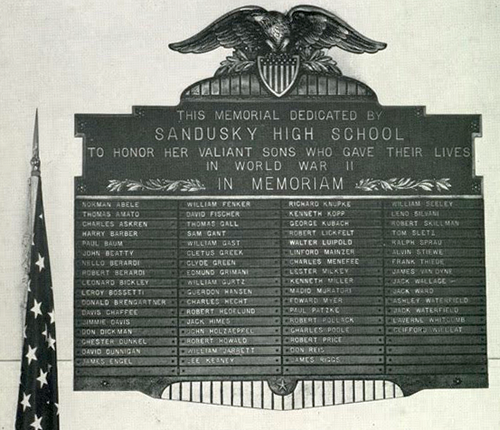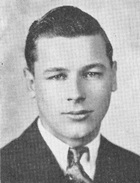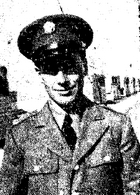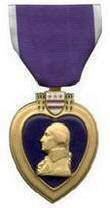Bus Stiewe
| Date and Place of Birth: | 1917 Sandusky, OH |
| Date and Place of Death: | February 15, 1945 Mezzano, Italy |
| Baseball Experience: | Minor League |
| Position: | Shortstop |
| Rank: | Corporal |
| Military Unit: | 388th Infantry Regiment, 85th Infantry Division, US Army |
| Area Served: | Mediterranean Theater of Operations |
Despite his small size, Alvin "Bus" Stiewe was a natural athlete. He
played football at Sandusky High School in Ohio and baseball with the
Commodore Denig Post. No. 83 Sandusky American Legion junior team that reached the state finals in
1933 (along with Paul "Butch" Baum, who was
killed in action in March 1944). In 1935, he was the shortstop and lead-off hitter with the Sandusky
Shamrocks of the Tri-County League (Baum was the catcher with that
team). In June of that year, both Stiewe and Baum were selected to play
for a Sandusky all-star team against the House of David.
In 1936, the year Stiewe graduated from high school, Sandusky entered a
team in the newly-formed Class D Ohio State League, and Stiewe was
signed as the Sandusky Sailors' shortstop. Playing in 97 of the Sailors'
98 regular-season games, he batted .303 with 49 RBIs and 15 stolen
bases. His 412 at-bats were a league high, while 89 runs scored and 125
hits were third best in the loop, earning him a place on the Ohio State
League all-star team. Stiewe was back with the Sailors in 1937, and
remained with the team when the franchise was moved to Marion, Ohio, on
June 22. He finished the year batting .260 in 92 games with a league
second-best 70 base-on-balls. The Marion Presidents left the Ohio State
League in 1938, and Stiewe remained with the team when they joined the
Central Ohio semi-pro league in April. However, he was soon back in the
Ohio State League, playing for the Findlay Browns and batting .303 in 81
games.
Stiewe returned to semi-pro ball in 1939, this time with the Norwalk
club and continued to play with local teams while working at the Hinde &
Dauch paper mill in Sandusky (he also played softball with Hinde &
Dauch). On March 28, 1942, he entered military service with the Army at
Camp Perry in Lacarne, Ohio and was assigned to the Coast Artillery,
operating anti-ship artillery or fixed gun batteries in coastal
fortifications. Private Stiewe trained at Camp Hulen with Battery B,
435th Battalion, transferring to Fort Bliss, Texas in July 1942, and
then Fort Bragg, North Carolina, before being assigned overseas later in
the year with the 692nd Coast Artillery (AA) Battery. He was involved in
Operation Torch (the Allied landings in North Africa) and, in
particluar, the Battle of Port Lyautey in French Morocco in November
1942, in which the American forces overcame strong resistence from the
French defenders.
By January 1943, still in North Africa, Stiewe had been promoted to corporal and transferred to the Machine Gun Battalion of the 692nd. He was involved in the invasion of Sicily in July of that year and described it in some detail in a letter to his parents:
| Landed on the beach of Gela between nine and 10 o'clock
morning of July 10. While waiting to get platoon over in front
of our boat to unload, enemy opened up with their artillery.
Sweated out a few 88 artillery shells for a while and one shell
hit between our boat and another that was unloading. Then we had
some peace before they got a silly notion to bomb us. They
bombed us for six hours. Soon as they dropped their bomb they
would go back and get another one, and be right back at us. They
dropped bombs all around the boat of which one bomb hit the
anchor chain which caused damage so that they could only use one
engine. Someone said that they dropped 34 bombs at us. That night a tug pulled us off the beach and out to sea where we got a good night's sleep. The nextt morning it looked like it was going to be a quiet day but sure changed in a hurry, I was on the gun when about 38 Ju88s came over. Our gun was jammed and couldn't get it to work so left the gun and dove under a truck which was close by. We were supposed to get off of the boat about 10 o'clock but Germans were shelling all along the beach with their artillery. Got our equipment down in the hole and ready to load on to another dock and it looked like daylight for Germans dropped a bunch of flares. These flares were over boats to the south of us. While watching them first thing we knew there were a couple of flares hanging over our boat. Then we heard a plane diving and let go with a bomb which hit a short distance from us. We went up to bed and first thing I heard was the three inch gun going off. Most of the fellows including myself had reached a stage that we didn't care whether they hit the boat or not, after all we had gone through. Sure was a battle of nerves. All I can say is that God was watching over us. I heard quite a few boys say the same thing. We are now in Italy and they keep us pretty busy doing carpenter work since we arrived. We get to town every night and don't have to pull guard. Keep the cigarettes coming. |
In Italy, Corporal Stiewe was at the Anzio beachhead and the drive to
Rome in June 1944. After this time, he was placed in a rest camp and
then assigned to the
338th Infantry Regiment of the 85th Infantry "Custer" Division in July
1944. He was with that unit at Mount Mezzano, overlooking the Po River
Valley, in February 1945.
Coprporal Stiewe wrote a letter to the members of Lowell C. Hein Post
2529 of the Veterans of Foreign Wars on February 11. Stiewe expressed
the hope that "this ball game will end in the not too far distant
future," and that "we'll get back home again to see how the people there
live." He told of the miserable civilian living conditions in Italy and
was especially enthusiastic because of having met Henry Stull, Al
Wilkens and Jim Sumser, all Sanduskians, whom, he wrote, "have been
chasing each other all over Africa and Sicily until we finally met in
Sicily."
Corporal Stiewe also took the time to compose a Valentine message to his mother, which read:
| How very dear you are to me! I never really knew, Till circumstances put me here, So far away from you. That's why I think of you each day, And send this Valentine To say that when I think of you, I can't help feeling fine! |
The day after Valentines Day 1945, Stiewe was killed during a patrol in
Mezzano, Italy. He
was buried at Florence American Cemetery in Via Cassia, Italy. News of
his death reached Sandusky at the beginning of March 1945. On March 18,
a memorial service was held at the Community Gospel Church in honor of
Stiewe.
In 1947, a plaque was unveiled at Sandusky High School listing the names of the former students who had died during World War II.
In May 1963, the Sandusky Register printed a letter suggesting that the local Little League baseball field be named after Bus Stiewe. The letter read as follows:
| To the Editor of the Register; Last week I read in your paper that a movement was afoot to change the name of the "Sewage Disposal Plant Little League Park." I think that everyone will agree that this is not exactly a satisfactory name. "I am a Little League manager and I try as best I can to teach these boys to play baseball. Also we try to teach them to be sportsmen and gentlemen. Almost all of these boys have a ballplayer who is their personal idol, and fondly dream that someday they too will be stars of the game. In my mind, one such ballplayer stands out...This boy's name was "Bus" Stiewe. Bus was a fine ballplayer, but more important, he was a fine gentleman. His personal habits were exemplary. Physically, he was a fine example of clean living and faithful training. Bus always gave 100 per cent in every game in which he played. During World War II, Bus served in Italy. He was at Anzio Beachhead among other campaigns. I corresponded with him regularly, and at no time did he gripe or complain of the terrible living conditions there. Just a few days before he was to go home, he was killed in action. His untimely death was a shock which I can never forget. I knew Bus intimately for 15 years, and no man could ever have the privilege of knowing a finer person. Sandusky had lost a fine athlete and gentleman. Now here is my idea. Why can't the City of Sandusky dedicate this ball park to the memory of a fine person? This park could be called "The "BUS" STIEWE MEMORIAL FIELD." Couldn't a sign or placque be erected at the field giving a short history of this fine person. A finer example for these Little League players can not be found. I would like to hear the opinions of some of Bus old teammates and friends, and see if this project could become a reaUty. This could be a beautiful monument in the memory of a fine man. Please, can we get this project rolling? NAME SUBMITTED Withheld by Request |
Unfortunately, although this idea appeared in newspapers again in 1966, I can find no record to suggest it was ever put in action.
|
Team |
League |
Class |
G |
AB |
R |
H |
2B |
3B |
HR |
RBI |
AVG |
|
| 1936 | Sandusky | Ohio State | D | 97 | 412 | 89 | 125 | 23 | 3 | 5 | 49 | .303 |
| 1937 | Sandusky/Marion | Ohio State | D | 92 | 354 | 81 | 92 | 19 | 3 | 1 | 38 | .260 |
| 1938 | Findlay | Ohio State | D | 81 | 320 | 67 | 97 | 18 | 2 | 0 | 36 | .303 |

The plaque at Sandusky High School dedicated to former students who lost their lives during World War II
Sources
Sandusky Register Star-News, April 6, 1942
Sandusky Register Star-News, July 18, 1942
Sandusky Register Star-News, August 6, 1942
Sandusky Register Star-News, October 9, 1942
Sandusky Register Star-News, January 4, 1943
Sandusky Register Star-News, January 5, 1943
Sandusky Register Star-News, August 10, 1943
Sandusky Register Star-News, December 2, 1943
Sandusky Register Star-News, December 10, 1943
Sandusky Register Star-News, January 22, 1944
Sandusky Register Star-News, May 26, 1944
Sandusky Register Star-News, August 5, 1944
Sandusky Register Star-News, November 20, 1944
Sandusky Register Star-News, March 5, 1945
Sandusky Register Star-News, March 7, 1945
Sandusky Register Star-News, March 8, 1945
Sandusky Register Star-News, March 17, 1945
Sandusky Register Star-News, May 31, 1947
Sandusky Register, May 3, 1963
Date Added April 13, 2012 Updated June 10, 2014
Baseball's Greatest Sacrifice is associated with Baseball Almanac
Baseball's Greatest Sacrifice is proud to be sponsored by



